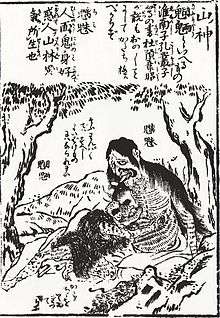Chimimōryō

Chimimōryō (Chinese: 魑魅魍魎; pinyin: Chīmèi wǎngliǎng) is a term, originated from China dating roughly 2,500 years in ancient chronicles such as the Zuo Zhuan, referring to monsters of the mountains and monsters of the rivers. It refers to various kinds of obake and things changed into yōkai. "Chimi" (魑魅) refers to the monsters of the mountains, and "mōryō" (魍魎) refers to the monsters of the river,[1] and so the word "chimimōryō" is often used to refer to all monsters of the mountains and rivers.[2] Furthermore, the word "minori" was also used for this. For this to be used to mean a "ripening" (minoru) oni has been used in various regions since ancient times.
Explanation
Chimi
Chimi are said to be monsters that come about from strange atmosphere (miasma) in mountains and forests. Taking on an appearance with the face of a human, and the body of a beast, they would perplex humans. In the dictionary Wamyō Ruijushō from the Heian period, they were considered to be a type of oni under the Japanese name "sudama", and in the Edo period encyclopedia, the Wakan Sansai Zue, they were seen to be mountain gods (Yama-no-Kami).[3]
Mōryō
Mōryō were considered to be spirits from mountains and rivers, and trees and rocks. They would come forth from the life energy of mountains, water, trees, rocks, and all kinds of things in nature, and fool humans. Additionally, they are also said to eat the dead, have the appearance of a child, stand on 2 feet, have dark red skin, have red eyes, long ears, beautiful hair, and a voice that resembles that of a human. With this kind of appearance, they are thought to be oni. In the Wakan Sansai Zue, they are considered water gods (Suijin), and in the ancient Chinese book Zuo Zhuan, they are considered to be gods of swamps and marshes.[3]
Etymology
There are many theories about its etymology, but according to the Records of the Grand Historian (during the period of the Five Emperors), a 魑 is a mountain god that took on the shape of a tiger, and a 魅 is a swamp or marsh god taking on a shape with the head of a beast, and it is surmised that from this, what the word was seen to mean expanded to encompass beasts of various attributes.